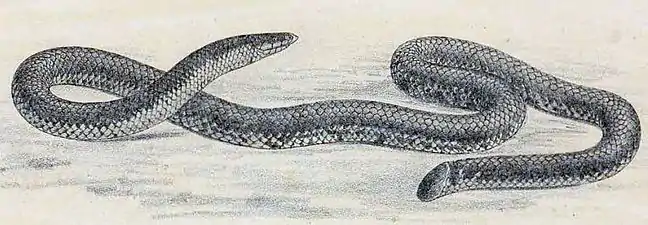| Rhinophis fergusonianus | |
|---|---|
 | |
| Illustration from the original species description published in 1896 by George Albert Boulenger | |
| Scientific classification | |
| Domain: | Eukaryota |
| Kingdom: | Animalia |
| Phylum: | Chordata |
| Class: | Reptilia |
| Order: | Squamata |
| Suborder: | Serpentes |
| Family: | Uropeltidae |
| Genus: | Rhinophis |
| Species: | R. fergusonianus |
| Binomial name | |
| Rhinophis fergusonianus | |
Rhinophis fergusonianus, commonly known as the Cardamom Hills earth snake, is a species of uropeltid snake endemic to the Western Ghats, India.[3][1]
Etymology
The specific name, fergusonianus, is in honor of Scottish zoologist Harold S. Ferguson.[4]
Geographic range
R. fergusonianus is only known from the type specimen collected in the Cardamom Hills in Travancore, a part of the southern Western Ghats in modern Kerala, southeastern India.[3][1]
Description
The holotype of R. fergusonianus measures 32 cm (13 in) in total length (including tail), 40 times its width. The eyes are very small. The snout is acutely pointed. The body is longitudinally striated. It is blackish above, and the sides are white, dotted and spotted with black. The belly is white, with black dots and two series of large black spots, partially confluent into a zigzag band. The caudal disc is black and edged all round with yellow.[2]
Reproduction
R. fergusonianus is viviparous.[3]
Habitat and conservation
The habitats and ecology of this species, R. fergusonianus, and threats to it, are unknown.[1]
References
- 1 2 3 4 Srinivasulu, B.; Srinivasulu, C.; Vijayakumar, S.P.; Ganesan, S.R. (2013). "Rhinophis fergusonianus". IUCN Red List of Threatened Species. 2013: e.T178234A1528417. doi:10.2305/IUCN.UK.2013-1.RLTS.T178234A1528417.en. Retrieved 20 November 2021.
- 1 2 Boulenger GA (1896). "Description of a new earth snake from Travancore (Rhinophis fergusonianus)". Journal of the Bombay Natural History Society. 10: 236. (+1 plate)
- 1 2 3 Rhinophis fergusonianus at the Reptarium.cz Reptile Database. Accessed 24 January 2017.
- ↑ Beolens, Bo;Watkins, Michael; Grayson, Michael (2011). The Eponym Dictionary of Reptiles. Baltimore: Johns Hopkins University Press. xiii + 296 pp. ISBN 978-1-4214-0135-5. (Rhinophis fergusonianus, p. 89).
Further reading
- Boulenger GA (1896). Catalogue of the Snakes in the British Museum (Natural History). Volume III., Containing the Colubridæ (Opisthoglyphæ and Proteroglyphæ), Amblycephalidæ, and Viperidæ. London: Trustee of the British Museum (Natural History). (Taylor and Francis, printers). xiv + 727 pp. + Plates I-XXV. (Rhinophis fergusonianus, p. 596).
- McDiarmid RW, Campbell JA, Touré TA (1999). Snake Species of the World: A Taxonomic and Geographic Reference, Volume 1. Washington, District of Columbia: Herpetologists' League. 511 pp. ISBN 1-893777-00-6 (series), ISBN 1-893777-01-4 (volume). (Rhinophis fergusonianus, p. 137).
- Sharma RC (2003). Handbook: Indian Snakes. Kolkata: Zoological Survey of India. 292 pp. ISBN 978-8181711694.
- Smith MA (1943). The Fauna of British India, Ceylon and Burma, Including the Whole of the Indo-Chinese Sub-region. Reptilia and Amphibia. Vol. III.—Serpentes. London: Secretary of State for India. (Taylor and Francis, printers). xii + 583 pp. (Rhinophis fergusonianus, pp. 90–91).
